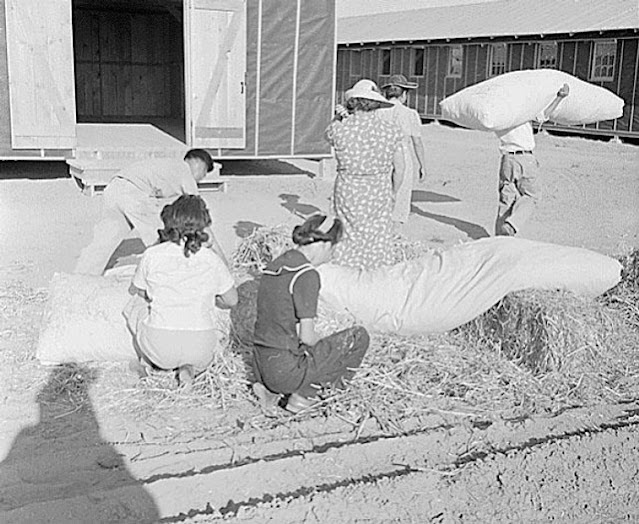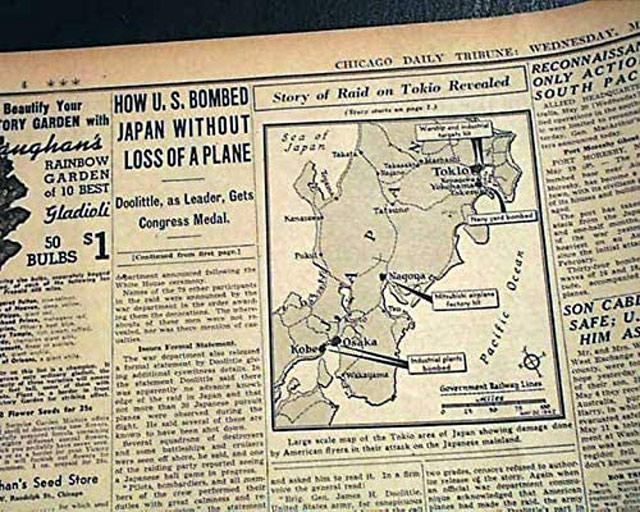Thursday 21 May 1942
 |
| P-36C Ser. No. 38-204, 61st Pursuit Squadron, skids off the runway after mechanical failure at Bridgeport Airport in Connecticut, 21 May 1942. The pilot, Lt. George D. Hobbs, is uninjured. |
Battle of the Pacific: Japanese Admiral Nagumo sails his Kido Butai carrier force out of the inland sea port of Sasebo on 21 May 1942. His crews spend the day practicing fleet maneuvers as they head through the Bungo Strait. Badly damaged at the Battle of the Coral Sea, aircraft carrier Zuikaku limps into Kure today. It is unavailable for the upcoming attack on Midway.
The Americans remain in doubt about the next target of Japanese aggression, though many officers in naval intelligence suspect it is Midway. Seeking definitive proof, decryption teams in Washington, D.C., Honolulu, and Melbourne, Australia spend the day working on a stack of intercepted Japanese radio messages. These include one long message that has been flagged for priority processing. Japanese radio intelligence operators, meanwhile, also notice an increase in American radio traffic out of Hawaii. They intercept 180 messages and note that 72 are marked as urgent.
The Japanese continue their gradual occupation of the Philippines. After landings in the Leyte Gulf, they enter the city of Bacolod, Leyte, and Samar. Organized Allied resistance ended with the fall of Corregidor, so the Japanese only have to contend with occasional guerrillas.
US Army Air Force B-26 bombers attack Lae, New Guinea.
 |
| I-10 at Penang sometime in 1942. |
Battle of the Indian Ocean: Japanese submarine I-10, part of A Detachment which is scouting the Indian Ocean for targets, surfaces off Durban, South Africa. The crew launches its E14Y1 floatplane to perform reconnaissance. The pilot spots no targets and quickly flies back to the submarine when challenged by Allied forces over the radio. This is the first Japanese venture to Africa during the war.
Eastern Front: Marshal Timoshenko, belatedly concerned about the mortal danger to his forces south of Kharkov posed by German counterattacks, spends the day regrouping his forces. The Luftwaffe has complete aerial supremacy and wrecked Red Army vehicles block many roads.
At Fuhrer Headquarters, General Franz Halder notes that "The situation at Kharkov continues to develop to our satisfaction." After writing that an encircled German force at Ternovaya (northeast of Kharkov) has been relieved, he continues that "We can now take out forces from this sector [north of Kharkov] and get them ready to meet Kleist, converging from the north." He concludes that Kleist's advance is taking "a gratifying course" and "we are now recapturing the initiative." Throughout the middle years of the war, "having the initiative" is a major aim of both sides, sometimes to their detriment.
 |
| Supply difficulties on the Eastern Front are shown on the cover of the 21 May 1942 Illustrierter Beobachter. |
Southeast of Kharkov, Kleist's panzers of the 14th Panzer Division advance another four miles. This reduces the Soviet breakout point through which all of their supplies flow to Timoshenko's troops to the west from 12 to 8 miles. The Germans remain puzzled that the Red Army on either side still has not attempted to pierce the thin line that the Wehrmacht is establishing east of Timoshenko's armies.
Halder sums up Manstein's victory in Operation Trappenjagd: "Kerch operation concluded. Regrouping at Sevastopol, where the enemy is evidently making preparations against our impending attack."
There is an oblique but telling reference in Halder's diary to the German high command's condescending attitude toward its allies. He writes that the Hungarian military attache visited during the day and requested information about the Kharkov battle. Halder notes simply, "I politely refuse." This is a peculiar attitude considering the key role that the allied troops are projected to play in the upcoming "decisive" summer offensive, Case Blau. However, it also is quite common in the Wehrmacht.
European Air Operations: An extended spring lull continues for both sides over the Channel Front. The only major action is the RAF sending 33 Wellington and 15 Stirling bombers of No. 3 Group to lay mines at the Biscay ports. However, poor weather permits only 18 bombers to complete the mission. No aircraft are lost.
 |
| U-106. Its sinking of a Mexican oil tanker on 21 May 1942 leads to a declaration of war. |
Battle of the Atlantic: U-106 (Kptlt. Hermann Rasch), on its sixth patrol out of Lorient, torpedoes and sinks 6067-ton Mexican oil tanker Faja de Oro. There are ten deaths and 21 survivors. This sinking, along with other events, leads Mexico to declare war on Germany.
It isn't really Rasch's fault that this leads to war, of course. He is just doing the job asked of him and the sinking of neutral ships is quite common by 21 May 1942. In fact, if U-106 didn't sink Faja de Oro, another U-boat was in a position to do so. U-754 was stalking Faja de Oro and watched as U-106 torpedoed it. Two U-boats were ready to do the deed. So, the tanker was doomed and Mexico was fated to declare war.
U-103 (Kptlt. Werner Winter), on its seventh patrol out of Lorient, torpedoes and sinks 3372-ton US freighter Clare 40 nautical miles (74 km) south of easternmost Cuba. All 40 crewmen survive, either reaching land in their lifeboats or picking up by a Cuban naval vessel.
U-103 also torpedoes and sinks 4727-ton US freighter Elizabeth about 30 nautical miles (56 km) south of Cape Corrientes, Cuba. There are six deaths and 36 survivors.
 |
| U-201 returning to Brest, 21 May 1942. the crew has the binoculars out to see what is in port (Leskin, Federal Archive Image 101II-MW-4939-22). |
U-159 (Kptlt. Helmut Friedrich Witte), on its second patrol out of Lorient, gets its first two victories of the war today. It torpedoes and damages 2646-ton Royal Fleet Auxiliary RFA Montenol 140 nautical miles (260 km) southeast of Santa Maria Island, Azores. RFA Montenol is with convoy OS 28. There are three deaths and 61 survivors, who are rescued by HMS Woodruff. RFA Montenol is deemed unsalvageable and is scuttled by HMS Wellington.
U-159 also torpedoes and sinks 6529-ton British freighter New Brunswick 140 nautical miles (260 km) southeast of Santa Maria Island, Azores. New Brunswick is part of Convoy OS 28. There are three dead and 59 survivors, who are rescued by British freighter Inchaga, HMS Totland, HMS Weston, and HMS Woodruff.
 |
| Canadian freighter Troisdoc, sunk by U-558 on 21 May 1942. |
U-558 (Kptlt. Günther Krech), on its seventh patrol out of Brest, torpedoes and sinks 1925-ton Canadian freighter Troisdoc west of Jamaica. All 18 crewmen survive and are rescued by USCGC Mohawk.
U-156 (Kptlt. Werner Hartenstein), on its third patrol out of Lorient, torpedoes and sinks 1738-ton Dominican Republic freighter Presidente Trujillo off Fort-de-France, Martinique. There are 24 dead and 15 survivors.
U-69 (Oblt. Ulrich Gräf), on its eighth patrol out of St. Nazaire, torpedoes and sinks 1927-ton Canadian freighter Torondoc 60 nautical miles (110 km) northwest of Martinique. All 22 crewmen perish.
After two weeks at sea, four survivors of Neosho (AO-23) are rescued by the destroyer USS Helm (DD-338).
Convoy PQ 16 departs Iceland, bound for Murmansk.
 |
| An article about expressive dance in the 21 May 1942 Illustrierter Beobachter. |
Battle of the Mediterranean: British troops in Malta find a man in bad condition in a cave beneath the Dingli cliffs and bring him to Imtarfa military hospital for treatment. He identifies himself under a phony name, Caio Borghi. By chance, he is recognized at the hospital by a boyhood neighbor who now is a captain in the British Army. The man, Carmelo Borg Pisani, then admits to being an Axis spy sent to report on conditions on Malta.
The Luftwaffe continues its recent pattern of sending Bf 109 fighter-bombers on sweeps over Malta. The RAF attempts to intervene, but is usually too slow to arrive. On one of these attacks over Hal Far aerodrome, they kill two men and wound three others. One of the deaths is Sgt. Dewhurst, recently awarded the Military Medal.
 |
| A postcard commemorating the laying of the keel of USS Pargo on 21 May 1942. |
US Military: Having been greatly reinforced in recent days by troops brought over to Northern Ireland by liner Queen Mary and other transport ships, US Army medical battalions begin taking over some facilities. These include hospitals at Musgrave Park on the outskirts of Belfast and at Irvinestown.
North Pacific Force is established in Alaska. It controls all US and Canadian forces in the region. Its first commander is Rear Admiral Robert A. Theobald.
Holocaust: German forces deport 4300 Jewish residents of Chelm to the death camp at Sobibor. All are gassed to death.
German firm IG Farben establishes a factory outside the Auschwitz extermination camp in order to profit from slave labor.
 |
| Deportation of Slovak Jews. Stropkov, Czechoslovakia, May 21, 1942. |
American Homefront: MGM releases "Tortilla Flat," directed by Victor Fleming and starring Spencer Tracy, Hedy Lamarr, John Garfield, Frank Morgan, and Akim Tamiroff. Morgan is nominated for the Academy Award for Best Supporting Actor.
In her 'My Day" syndicated column, First Lady Eleanor Roosevelt notes that many women in New Mexico have volunteered and been trained as nurses. They now are "being used in all clinics and hospitals throughout the state." This frees up trained nurses and doctors for other tasks.
Ted Williams goes 3-5 with a home run and four RBIs in an 8-3 Boston Red Sox victory over Cleveland. This is his last game before joining the U.S. Navy on 22 May. After being sworn in, Williams returns to the Red Sox and finishes out the season, coming in second in MVP voting to NY Yankees second baseman Joe Gordon.
Future History: Danny Ongais is born in Kahului, Hawaii. He serves in the US Army in Europe in the late 1950s as a paratrooper, then returns to Hawaii and enters motor racing. He becomes a top drag racer, winning the AA Gas Dragster Championship in 1963 and 1964, and in the National Hot Rod Association AA Dragster championship title in 1965. He enters Championship Auto Racing Teams (CART) in 1979 and races in several Indianapolis 500 races. To date, Ongais, who becomes known as the "Flyin' Hawaiian" due to his flamboyant personality, is the native Hawaiian to race in the Indianapolis 500. Danny Ongais is inducted into the Motorsports Hall of Fame of America in 2000 and retires from racing in the late 1980s, though he returns for a final race in 1996 and remains associated with the sport for years afterward.




















